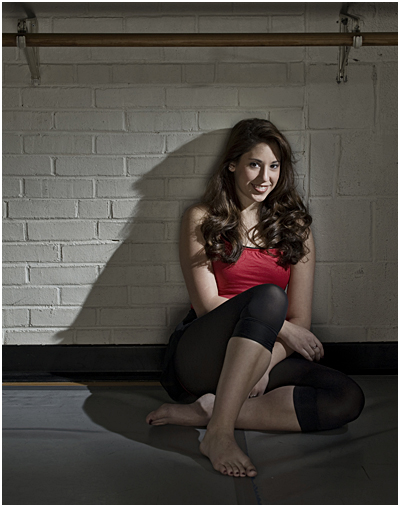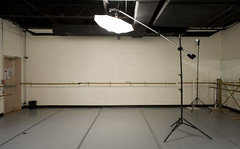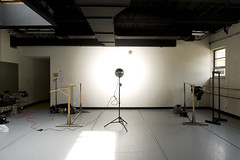On Assignment: HCAC Dancer

I am working on several projects this summer, the most enjoyable of which being a series of portraits for the Howard County Arts Council.
I photographed Kassi, a dancer, for this series and got a chance to play with one of the two-light techniques we talked about earlier. This was also the first chance I got to use a new boom setup that is a little heavier duty than the one featured earlier this week.
__________
Riaz Redux
I normally like to play around with new lighting styles before trying them out on an assignment. In this case, I used the small-flash lighting class in Dubai earlier this year as the guinea pig for this shoot. You might recognize the top photo as being lit similarly to that of Riaz, the first example in the two-light portrait series.
There are a couple of differences, but the grid key / umbrella fill was a common denominator for both. In shooting Riaz, I had the umbrella squished right up under the lens. With Kassi, I put the umbrella on the floor with a flash mounted to it but with no stand.
I used an umbrella swivel adapter to attach an SB-800, and stuck the assembly on the ground. The umbrella rests at about the correct angle for uplighting a low-to-the-ground subject by itself.
Ratios were done without a meter and without regard to any absolute settings, as usual. I positioned the fill light first and altered my flash power and/or aperture until I saw a nice baseline exposure for the frame.
Generally, I like to get it to a full exposure, and then drop my power level on the flash or close down the aperture until I get a nice looking floor to the fill light. The idea is to use the fill as a sort of safety net, to lift the shadows that will be formed by the key light, lest they get too dark and contrasty. If you are coming from off axis with the fill, you'll also introduce a second angle to the overall light.
I really liked the look of the low-in fill, as it gave its own shape to the subject -- much more so that would an on-axis fill. But as much as I liked the shape of the fill, I was going back and forth on the shadow that it threw over Kassi's head and shoulders.
In the end, I wanted the direction of the light, but not the shadow. So I toned the latter way down in post. There is definitely a procedural learning curve for me, even two full years after leaving the tightly controlled Photoshop environment of The Sun.
I have to remember to loosen up, as my default is typically to "do it the newspaper way." But then I remember if I were personally doing everything the newspaper way today, I would be drowning in debt and arbitrarily lopping off perfectly good body parts in a misguided attempt to get a "good return on investment."
 Oh well. Back to the light.
Oh well. Back to the light. The key, as you can see, is a gridded SB-800. We have already locked in the fill level and shooting aperture, so the key level is set by altering the flash's power level. (We can also move the flash closer or further away, but that would change the look of the light.)
Unlike the grid on Riaz, I wanted to catch Kassi's face and body with the key but mostly miss the wall on the leading edge. This way I could control the tone in the white wall, even though she was leaning against it. To do that, I didn't aim the grid at her face, but rather out in front of her face a little bit. So her face is nearer to the edge of the beam than in the center of it.
A grid on a speedlight is a very small light source and thus produces very hard shadows at this distance. But I know they won't fall too far off of the table because I built my fill light first. The combination is soft vs. hard, high vs. low and tight light vs. everywhere light brings a lot of different contrast layers into play. If I wanted, I could have used a 1/2 CTB on the fill and a 1/2 CTO on the key to add a neat color contrast in there, too.
A Bigger Boom
 For another look, we wanted to do Kassi dancing. She is very athletic, and incorporates that into her routines. So we set up to light a photo of her leaping.
For another look, we wanted to do Kassi dancing. She is very athletic, and incorporates that into her routines. So we set up to light a photo of her leaping.I knew she would be looking back over her shoulder at me, and wanted to light her face from a flattering angle. To do that, you have to find the position of her face and then get the light wherever it need to be to hit that angle.
In Kassi's case, to three-quarter light her, we'd have to be above, behind and camera-right of her face when she looked over her shoulder. So we were going to need to get the key up pretty high -- especially considering we'd be going through an umbrella, too.
For that I used a bigger, heavier-duty boom than the Interfit model we talked about earlier this week. I used a Paul Buff counter-weighted boom arm attachment on a 13-foot light stand. I got this to be able to get my bigger flash heads up high. And while it is not super heavy duty, it is sufficient for that kind of work.
You buy it in two pieces -- the stand and the boom arm. The stand is a heavy-duty, 13-foot stand, which is also a great thing to have kicking around when you need it. The boom assembly includes a two-section extension pole, a multi-angle clamp and comes with an 11-pound, slide-able counterweight. They total up to $160.
Needless to say, this is rock solid for a speedlight, and I also have been happy with it in a supporting role for both my SB's and my WL's.
 So, here's the setup. The key light is above/behind/camera right, through an umbrella. There is a back/separation light (an SB-800) hiding way back at camera right on a compact, 5-section stand.
So, here's the setup. The key light is above/behind/camera right, through an umbrella. There is a back/separation light (an SB-800) hiding way back at camera right on a compact, 5-section stand.The key light location was trial and error, done as Kassi worked through a few practice leaps. In the end, it was a perfectly logical location, given the position of her face. Kassi's leap put her about two feet in front of, and to camera left, of the umbrella.
The fill was a bigger problem, as we could not just open the shutter to let if build up the ambient. By balancing that way, we would have lost the shutter needed to freeze the leap. So it would all have to come from flash.
It had to be soft, come from close to on-axis and reach back to light the back wall, too. So I needed a physically big light source, coming from the camera's direction and pretty far back. Fortunately, our room was a neutral, light color, so the wall 15 feet or so behind me became my modifier.
 I fired a WL 600 into that wall, building a nice, soft, directionless fill that would be far enough back to reach back to the background wall without losing too much oomph. My shooting position was about three feet in front of the light.
I fired a WL 600 into that wall, building a nice, soft, directionless fill that would be far enough back to reach back to the background wall without losing too much oomph. My shooting position was about three feet in front of the light.If you are in a neutral room, always consider your walls as possible huge bounce surfaces that you can employ as everything from a soft key to a humongous soft ring-like fill. But you'll need some power if you are going to use it over a large area.
This is one of many examples of a way in which you can use a monobloc with smaller flashes. Ironically, the SB is my key and the WL 600 is the fill. This doesn't make a lot of sense, unless you consider how much more efficient a close-in, umbrella'd light is than another light bounced way back off of a wall and having to carry another 30-40 feet after that.
Having a big light in your back allows you wallpaper fill light over a large area while accenting with speedlights.
__________
Read More: On Assignment
__________
New to Strobist? Start here | Or jump right to Lighting 101
My new book: The Traveling Photograher's Manifesto
Permalink
<< Home